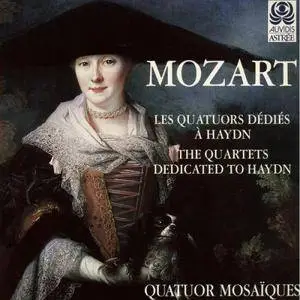Quatuor Mosaïques - Mozart: Les quatuors dédiés à Haydn (2017)
Classical | MP3 CBR 320 kbps | 03:37:13 | 499 MB
Label: Naïve Classiqe | Release Year: 2017
Classical | MP3 CBR 320 kbps | 03:37:13 | 499 MB
Label: Naïve Classiqe | Release Year: 2017
Quatuor Mosaïques is among the leading original instrument or authentic performance string quartets. Its members were all part of the Concentus Musicus Wien, the pioneer original instruments group associated with Nikolaus Harnoncourt. In 1983 Christoph Coin, the cellist and viola da gamba player of the Concentus Musicus, founded Ensemble Mosaïques, a smaller group, inviting a number of his colleagues from Concentus Musicus to join. In 1985, four members of Ensemble Mosaïques formed the Quatuor Mosaïques, one of the first string quartets devoted to use of period instruments and authentic performance practices. Its members are Erich Hobarth, who plays a 1683 violin by Francesco Ruggieri of Cremona; Andrea Bischof, with an eighteenth century French violin; Anita Mitterer, who plays a viola made by Chrisopher Lüthi as a replica of an Amati instrument; and Coin, whose cello was made by Carlo Antonio Testore of Milan in 1758. It is not particularly the age of a string instrument that makes it a "period instrument." Many string players have instruments that were made in the Baroque era that are classified as modern instruments. Rather, it is the way the instrument is set up. Instruments intended to be authentic to the Baroque and most of the Classical period have bridges that are shaped differently than the modern violin bridge, use gut strings (rather than today's wire or wire-wrapped strings), lack a chin rest, and are played with a convex rather than a concave bow. These differences give the Quatuor Mosaïques a very different sound from a modern string quartet. The instruments have a clearer though less penetrating sound, and the different style of bow softens the attack of a note. Since the string quartet was apparently not perceived until the mid-eighteenth century, the Quatuor Mosaïques repertory is virtually confined to the Classical period and part of the early Romantic era, but this is a rich field, including the many quartets of Mozart, Beethoven, Schubert, both Haydn brothers, Boccherini, and others. Quatuor Mosaïques rapidly became well known for its informed and stylistically correct approach to this repertory, and for the accuracy and poetic nature of its performances. Soon it was invited to perform in major European festivals, including the Vienna Festival Week, the Salzburg Festival, Resonances, the Styrian Arts Festival, the Edinburgh Festival and the Aldeburgh Festivals in Great Britain, and others. It has performed in major European cities and has presented complete Beethoven quartet cycles in several venues. It records for the Auvidis/Astrée and Auvidis/Valois labels and has received Gramophone Awards for its sets of the opus 20 and opus 33 quartets by Joseph Haydn, and the Diapason d'Or and Recording of the Year 1989 for its set of Haydn's opus 77 quartets and the opus 103 quartet.
TRACKLIST
CD1
01. String Quartet No. 14 in G Major, Op. X No. 1, K. 387 "Spring Quartet": I. Allegro vivace assai
02. String Quartet No. 14 in G Major, Op. X No. 1, K. 387 "Spring Quartet": II. Menuetto. Allegro
03. String Quartet No. 14 in G Major, Op. X No. 1, K. 387 "Spring Quartet": III. Andante cantabile
04. String Quartet No. 14 in G Major, Op. X No. 1, K. 387 "Spring Quartet": IV. Molto allegro
05. String Quartet No. 15 in D Minor, Op. X No. 2, K. 421: I. Allegro
06. String Quartet No. 15 in D Minor, Op. X No. 2, K. 421: II. Andante
07. String Quartet No. 15 in D Minor, Op. X No. 2, K. 421: III. Menuetto
08. String Quartet No. 15 in D Minor, Op. X No. 2, K. 421: IV. Allegretto ma non troppo
CD2
01. String Quartet No. 17 in B-Flat Major, Op. X No. 3, K. 458: I. Allegro vivace assai
02. String Quartet No. 17 in B-Flat Major, Op. X No. 3, K. 458: II. Menuetto
03. String Quartet No. 17 in B-Flat Major, Op. X No. 3, K. 458: III. Adagio
04. String Quartet No. 17 in B-Flat Major, Op. X No. 3, K. 458: IV. Allegro assai
05. String Quartet No. 16 in E-Flat Major, Op. X No. 4, K. 428: I. Allegro non troppo
06. String Quartet No. 16 in E-Flat Major, Op. X No. 4, K. 428: II. Andante con moto
07. String Quartet No. 16 in E-Flat Major, Op. X No. 4, K. 428: III. Menuetto
08. String Quartet No. 16 in E-Flat Major, Op. X No. 4, K. 428: IV. Allegro vivace
CD3
01. String Quartet No. 18 in A Major, Op. X No. 5, K. 464: I. Allegro
02. String Quartet No. 18 in A Major, Op. X No. 5, K. 464: II. Manuetto
03. String Quartet No. 18 in A Major, Op. X No. 5, K. 464: III. Andante
04. String Quartet No. 18 in A Major, Op. X No. 5, K. 464: IV. Allegro non troppo
05. String Quartet No. 19 in C Major, Op. X No. 6, K. 465 "Dissonances": I. Adagio - Allegro
06. String Quartet No. 19 in C Major, Op. X No. 6, K. 465 "Dissonances": II. Andante cantabile
07. String Quartet No. 19 in C Major, Op. X No. 6, K. 465 "Dissonances": III. Menuetto
08. String Quartet No. 19 in C Major, Op. X No. 6, K. 465 "Dissonances": IV. Allegro molto



